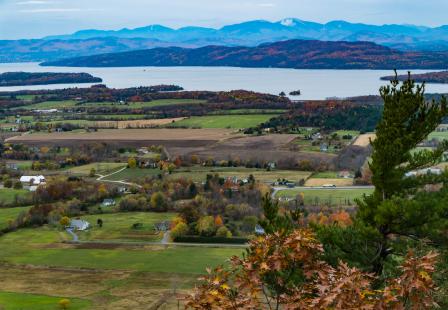Working with Farmers to Reduce Phosphorus in Lake Champlain
Originally Published Novermber 20, 2017. Updated March 7, 2019
When you think of Vermont, you probably think of dairy farms. The dairy industry makes up 70% of Vermont’s agricultural sales and provides $360 million in annual salaries and wagesExit. Many Vermont dairy farms are located in the Lake Champlain watershed.
 Lake Champlain runs along the western border between Vermont and New York and is the sixth largest body of freshwater in the United States. It is also a drinking water source and supports tourism in the region. The lake is impaired by phosphorus. Excess amounts of the nutrient can cause algal blooms, reduce water clarity, create obnoxious odors, harm aquatic life, and reduce recreational use. A recent studyExit found that Vermont communities would face a $12.6 million drop in lake-related tourism for every meter decline in water clarity.
Lake Champlain runs along the western border between Vermont and New York and is the sixth largest body of freshwater in the United States. It is also a drinking water source and supports tourism in the region. The lake is impaired by phosphorus. Excess amounts of the nutrient can cause algal blooms, reduce water clarity, create obnoxious odors, harm aquatic life, and reduce recreational use. A recent studyExit found that Vermont communities would face a $12.6 million drop in lake-related tourism for every meter decline in water clarity.
EPA researchers are currently working with small Vermont dairy farmers to explore whether pasture-based rotational grazing can be a viable, cost-effective, option for small farms to help to reduce phosphorus loadings to the lake. In June 2016, EPA Region 1 released pollution budgets for the Vermont segments of the lake. This Total Maximum Daily Load, or TMDL, places a limit on the maximum amount of phosphorus allowed to enter the lake and still allow it to meet Vermont's water quality standards. EPA determined that the amount of phosphorus entering the lake must be reduced by 34% overall to restore water quality. Additional reductions in New York and Quebec, which border the lake, also are needed. Agriculture is the largest source of phosphorus, and large reductions are needed from farms within the Lake Champlain watershed.
Since milk prices have remained consistently low, small dairy farms may face particular economic challenges when trying to meet these new limits. Pasture-based rotational grazing lets farmers use manure as a resource and reduces the need for and cost of equipment, while also encouraging practices that build soil health, reduce erosion, and decrease phosphorus flows into the lake.
Researchers want to identify the costs, benefits, and perceived barriers of adopting these practices. They’re also looking at the ability of a pasture-based system to meet the goals of reducing excess nutrients, improving sustainability in the farm communities, and increasing quality of life in the broader watershed. EPA is partnering with the Vermont Natural Resources Conservation Service, Vermont Department of Environmental Conservation, Vermont Agency of Agriculture, Food and Markets, the University of Vermont, and the Lake Champlain Basin Program on the project.
“We recognize that there will be tradeoffs and challenges for farmers to meet these limits,” says Dr. Stephen Balogh, a lead EPA researcher on the project. “This research can help state and federal regulators understand the barriers to implementation and work toward long-term sustainability for small farmers. We don’t just want the best ecological outcome. We want an equitable, socially acceptable solution that supports farmers in the region.”
The economic phase of this project is now nearing completion. Researchers hope that the work from this phase of the study will provide new insights to farmers, as well as the state and region, on the economic effects of implementing more ecologically friendly grazing practices.
